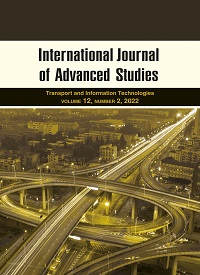РОБАСТНОЕ ПРОГНОЗИРОВАНИЕ ИНТЕНСИВНОСТИ ДВИЖЕНИЯ ТРАНСПОРТНЫХ ПОТОКОВ
Аннотация
Точная и своевременная информация о текущих и прогнозных параметрах транспортных потоков является важным условием функционирования интеллектуальных транспортных систем. Использование качественных данных позволит эффективнее решать задачу адаптивного управления транспортными потоками, снизить время движения, повысить точность планирования маршрутов поездок и в целом повысить эффективность использования транспортной инфраструктуры.
В данной статье представлено исследования воздействия светофорных объектов на регистрацию параметров транспортных потоков детекторами транспорта. Установлено, расположение зоны контроля детекторов транспорта в пределах участка формирования очереди транспортных средств ведет к искусственному зашумлению собираемых данных. Обосновано использования робастного прогноза параметров транспортного потока при решении задач адаптивного управления транспортными потоками.
Показано решение задачи робастного прогноза интенсивности движения с использованием модели LightGBM, основанной на алгоритме градиентного бустинга. Пространство признаков модели включало лаг интенсивности движения, дату и время полученных данных, признаки выходного дня и идентификатор группы полос движения. Робастность прогноза обеспечена за счет использования при вычислении функции ошибки модели сглаженного временного ряда методом LOWESS, при подаче на вход модели исходного, не сглаженного временного ряда.
Обученная на реальных данных модель имеет свойства робастности прогноза интенсивности движения, обеспечила фильтрацию стохастических колебаний и выбросов измеренных. При этом различает особенности суточных профилей для рабочих и выходных дней на всех группах полос, запаздывание прогноза наблюдалось только при наличии существенного отклонения наблюдаемой интенсивности от суточного тренда.
Скачивания
Литература
Essien, A., Petrounias, I., Sampaio, P., Sampaio, S.: Deep-PRESIMM: Integrating Deep Learning with Microsimulation for Traffic Prediction. IEEE International Conference on Systems, Man, and Cybernetics. IEEE Xplore, 2019, pp. 1–6.
Krajzewicz, D., Erdmann, J., Behrisch, M., Bieker, L.: Recent Development and Applications of SUMO – Simulation of Urban Mobility. International Journal on Advances in Systems and Measurements, 2012, vol. 5 (3&4), pp.128-138.
Lana, I., Del-Ser, J., Velez, M., Vlahogianni, E.I.: Road traffic forecasting: recent advances and new challenges. IEEE Intell. Transp. Syst. Mag., 2018, vol. 10, pp. 93–109. https://doi.org/10.1109/MITS.2018.2806634
Smith, B.L., Williams, B.M., Keith Oswald, R.: Comparison of parametric and nonparametric models for traffic flow forecasting. Transportation Research Part C: Emerging Technologies, 2002, vol. 10, pp. 303–321. https://doi.org/10.1016/S0968-090X(02)00009-8
Liu, Y., Wu, H.: Prediction of Road Traffic Congestion Based on Random Forest. 2017 10th International Symposium on Computational Intelligence and Design (ISCID). IEEE, 2017, pp. 361–364.
Dong, X., Lei, T., Jin, S., Hou, Z.: Short-Term Traffic Flow Prediction Based on XGBoost. 2018 IEEE 7th Data Driven Control and Learning Systems Conference (DDCLS). IEEE, 2018, pp. 854–859.
Wang, X., An, K., Tang, L., Chen, X.: Short term prediction of freeway exiting volume based on SVM and KNN. International Journal of Transportation Science and Technology. 2015. https://doi.org/10.1260/2046-0430.4.3.337
Philip, A.M., Ramadurai, G., Vanajakshi, L.: Urban arterial travel time prediction using support vector regression. Transportation in Developing Economies, 2018, vol. 4, 7. https://doi.org/10.1007/s40890-018-0060-6
Fu R., Zhang Z., Li L. Using LSTM and GRU neural network methods for traffic flow prediction. Chinese Association of Automation, 2017, pp. 324-328.
Essien, A., Petrounias, I., Sampaio, P., Sampaio, S.: The impact of rainfall and temperature on peak and off-peak urban traffic. International Conference on Database and Expert Systems Applications. Springer, Cham. 2018, pp. 399–407.
Goh, G., Koh, J., Zhang, Y.: Twitter-Informed Crowd Flow Prediction. 2018 IEEE Conference on Data Mining Workshops (ICDMW). 2018. pp. 624–631.
Ni, M., He, Q., Gao, J.: Using social media to predict traffic flow under special event conditions. The 93rd annual meeting of transportation research board. 2014.
Wongcharoen, S., Senivongse, T.: Twitter analysis of road traffic congestion severity estimation. 2016 13th International Joint Conference on Computer Science and Software Engineering, JCSSE 2016. IEEE 2016, pp. 1–6.
Essien, A., Petrounias, I., Sampaio, P. et al. A deep-learning model for urban traffic flow prediction with traffic events mined from twitter. World Wide Web. 2020. https://doi.org/10.1007/s11280-020-00800-3
LightAutoML – automatic model creation framework. URL: www.github.com/sberbank-ai-lab/LightAutoML (дата обращения 30.05.2021)
Cleveland, William S.. LOWESS: A program for smoothing scatterplots by robust locally weighted regression. The American Statistician. 1981, vol. 35 (1), 54. https://doi.org/10.2307/2683591
Просмотров аннотации: 237
Copyright (c) 2022 Alexey A. Vlasov

Это произведение доступно по лицензии Creative Commons «Attribution-NonCommercial-NoDerivatives» («Атрибуция — Некоммерческое использование — Без производных произведений») 4.0 Всемирная.







































